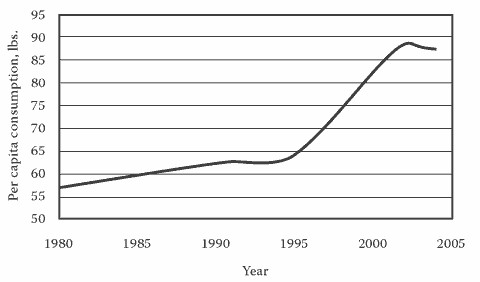
The graph above shows the roughly quarter-century trend in America’s per-capita fat consumption. To our great non-surprise, we’ve became rather fond of gorging on foodstuffs that we know to be deleterious to our waistlines, though we’re heartened to see that we’ve recently pulled back somewhat from the Popeyes-related brink.
Perhaps this trend has less to do with willpower, though, than the fact that science has darn nigh perfected the art of deep frying in recent years. Think it’s easy to pack both maximum taste and calories into a disc of pressed-together poultry parts? This passage from the not-to-be-missed Breaded Fried Foods should convince you otherwise:
A conceptual schematic of heat and mass transfer in the chicken nuggets is shown in Figure 2.3. A quarter symmetric sample model was partitioned into 330 triangle elements with 187 nodes using the automatic mesh generation of the FEMLAB software with the maximum element size of 1/15 of the maximum axis parallel distance in the sample geometry and the element growth rate as 1.3 (the maximum rate at which the element size can grow 30% from a region with small elements to a region with larger elements).
If similar scientific ingenuity were diverted from chicken-nugget production to space travel, would we have a colony on Mars within the next three years? We reckon so.


Captured Shadow // Dec 9, 2009 at 1:52 pm
Only 187 nodes? Seems inadequate to me, especially since the bread elements are going to have different properties from the chicken elements. I also would have to question the use of automatic meshing on a 1/4 model.
Actually the technology to do these kinds of analysis is pretty cheap and easy although but not really any good unless done by an experienced analyst and verified experimentally.
See if you can re-create the study results with this free package
http://www.lisa-fet.com/
Brendan I. Koerner // Dec 9, 2009 at 5:32 pm
Ah, I sometimes forget that I actually have some legit science-types in the audience.
Agreed, my last line was pure hyperbole. Still, I was struck by the mental capital that’s been invested in such a seemingly straightforward matter. Then again, getting McNuggets to taste exactly the same from Las Vegas to Lahore is no mean feat.
I wish the whole of Breaded Fried Foods was available via Google Books. I’d like to learn more about the tech, but I don’t have the $129 required to purchase a dead-tree version of my own:
http://www.amazon.com/Breaded-Fried-Foods-Parameswarakuma-Mallikarjunan/dp/0849314615
Jordan // Dec 9, 2009 at 6:05 pm
Also terrifying: using centrifugation to turn dark chicken meat into light meat.
http://www.physorg.com/news5711.html
Brendan I. Koerner // Dec 9, 2009 at 6:11 pm
@Jordan. Best line from that piece:
“We grind the meat up, add excess water and make essentially meat slurry,” he said.
Meat. Slurry. Let that abominable image marinate in your brain for a couple of seconds. Who said scientists couldn’t be poets, too?
Jordan // Dec 9, 2009 at 6:18 pm
@Brendan
Unfortunately, I have had to make such a concoction before in the course of my scientific career. The protein I was studying didn’t have a recombinant source, so I had to extract it from calf spleens. The process went something like this: I’d cut up the spleen with a razor blade (a somewhat labor-intensive task, because calf spleens are frickin’ huge and fibrous), run those chunks through a meat grinder, then mix the ground up spleen with buffer and run the whole mess through a blender (the guy who was working on the project before me blew up a couple of blenders because he hadn’t ground the chunks first and the membranes had caught and seized the motor). Then I’d have to slowly filter the slurry through cheese cloth to catch the gribbly bits. After that it was more straightforward protocols for precipitating various fractions and eventually doing a column purification to get my purified protein.
Suffice it to say, those first few steps were exceedingly unpleasant. There’s nothing like standing around in an almost-freezing room trying to squeeze the last bits of spleen juice out of cheese cloth.
All in a day’s thesis work…
Brendan I. Koerner // Dec 9, 2009 at 8:00 pm
@Jordan: The penultimate line of your comment above deserves serious Hall of Fame consideration. Talk about a word picture…
buskertype // Dec 9, 2009 at 11:14 pm
Meat slurries aside, that graph is terrifying. More than a 40% jump in under ten years? There must be some economic factors in play here too? Or is it just a generational change? Young people never learning to cook at home? My curiosity is aroused.
Brendan I. Koerner // Dec 10, 2009 at 9:52 am
@buskertype: Yeah, I was wondering the same thing–why the sudden jump starting in ’95? Is it because of the stagnation of real wages, which forced people to buy cheaper (and generally fattier) food? Or is it because of innovations (or even one specific innovation) that radically decreased the per-calorie retail price of junk food?
Perhaps some truly fat-laden dish made its debut in ’95? The Awesome Blossom? The jalapeno popper?